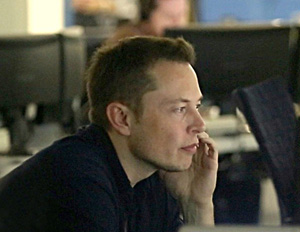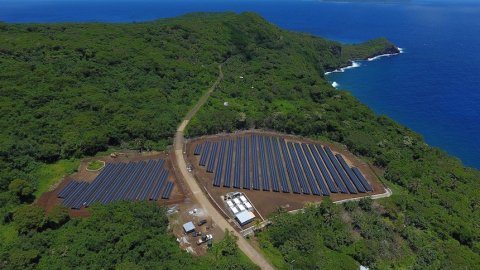2016 was a busy year for Tesla, with several significant Tesla solar developments:
- In October, Tesla President Elon Musk unveiled the company’s solar roof concept to be introduced after the company’s expected merger with SolarCity Corp.
- In November, Tesla became a clean-energy company when shareholders approved the acquisition of SolarCity in a $2.6 billion deal.
- Last week, Tesla announced its agreement with strategic partner Panasonic to begin the manufacturing of photovoltaic (PV) cells and modules at the Tesla-SolarCity factory in Buffalo, New York.
- The company also announced that it raised $241 million from its solar portfolio in a solar cash equity transaction with Sammons Renewable Energy (SRE).
- Tesla’s accelerated its island microgrid projects over the world. After powering the Island of Ta’u in and Ocracoke Island very recently, the company has now delivered 20 of its Powerpack systems for a Fiji luxury resort.

Tesla’s Elon Musk has ambitious plans for 2017
Today, the company announced that its Gigafactory has begun mass production of lithium-ion battery cells, which will be used in Tesla’s energy storage products and Model 3. The company is holding an investor event today at the gigafactory. This on the heels of a plunge for the volatile Tesla stock in the wake of its missed delivery deadlines for 2016. All these developments, heading into a year in which Tesla is introducing its much anticipated new vehicle, have elicited mixed reviews in the financial and renewable energy fields.
Some see incredible opportunities for Tesla’s success in the coming year…
Business Insider predicts 2017 will be Tesla’s “biggest year ever.” The publication offers its list of reasons that will propel the company to an even bigger year than 2016. On the Tesla Motors’ side, the year will see the launch of the highly anticipated new vehicle, development of a car-sharing network, strengthening of Tesla’s Supercharger program, a new streamlined manufacturing process, improvements and growth for the Autopilot feature, a possible partnership in China, and potential designs for additional vehicle types.
On the clean energy side, writes Business Insider senior correspondent Matthew DeBord, “The first important product from the Tesla-SolarCity tie-up will be the solar roof. Effectively, it will turn an entire roof into a giant, durable solar panel. It will also likely be an expensive product. But it will feed into Tesla’s other products — and provide Tesla with a way to free SolarCity from its current leasing model, moving toward selling solar solutions rather than loaning them out.”
DeBord believes there are three major tests Tesla must pass in 2017 to ensure its success: “Tesla’s major tests for 2017 fall into three categories: production, management, and financing,” he writes. The first is an on-schedule launch of the Model 3, the second is smooth integration of SolarCity into the Tesla business model, and the third is finances: getting a handle on cash and keeping stock prices up.
…while others fear the SolarCity merger will disappoint…
Over at MarketWatch, reporter Claudia Assis points to analysis that the solar market will slow in 2017 after years of high double-digit gains to growth of around 10% to 15% in the coming years, and a recession may be lurking in the year ahead. She writes:
“For SolarCity, the merger was seen as a way to access money much more easily. Wall Street, however, is less sanguine about how the deal would benefit Tesla. And one of the key concerns is how a pivot to solar power would sap attention away from the company’s core electric-car business in a potential slowdown.”
“Launching the Model 3 and dealing with the financials would be business as usual for a lot of companies,” says Assis. “However, those are tough tests for Tesla to pass, albeit far from impossible. It’s the SolarCity piece that’s the true major test.”
…and others are taking the long-range view
Boss Magazine‘s recent Tesla coverage is optimistic about Tesla’s chances for success. In a recent article, the publication says that although “it may be true that Tesla won’t see immediate benefits from this deal,” the company is playing a long game.
“Musk recently hinted that SolarCity would generate $1 billion more in revenue than Tesla next year and add $500 million in cash to Tesla’s balance sheet over three years,” the article concludes. “Tesla and SolarCity may not have it easy in the short run considering the political climate and financial concerns, but considering the huge size of the energy market and the growing significance of climate change, it simply makes sense to invest in renewables and solar.”

Tesla-SolarCity array on island of Ta’u, American Samoa
One way or another, we are moving to a renewable energy world, one that benefits from the vision of people like Musk and companies like Tesla. Many believe we have less time than current predictions before the world must make the switch to RE. The question is, how fast will the move happen and will Tesla make it to the tipping point? If it does, the company is uniquely positioned to lead in creating a clean-energy future.

Have there been any engineering analysis or research studies of the Ta’u island energy system performance and operation? This is an area of research for me and I would really like to take some students to study the system (we do whole system energy transition engineering) including the end uses and economic interactions of the energy system and other activities. I am putting my hand up if Tesla has $40k to pay student scholarship and travel, a rigorous study of this system could be important. (We get enough news feed material, the engineers working in the field need real information)
These would be questions for Tesla. If you do go the island, please stay in touch, we’d love to hear about it!